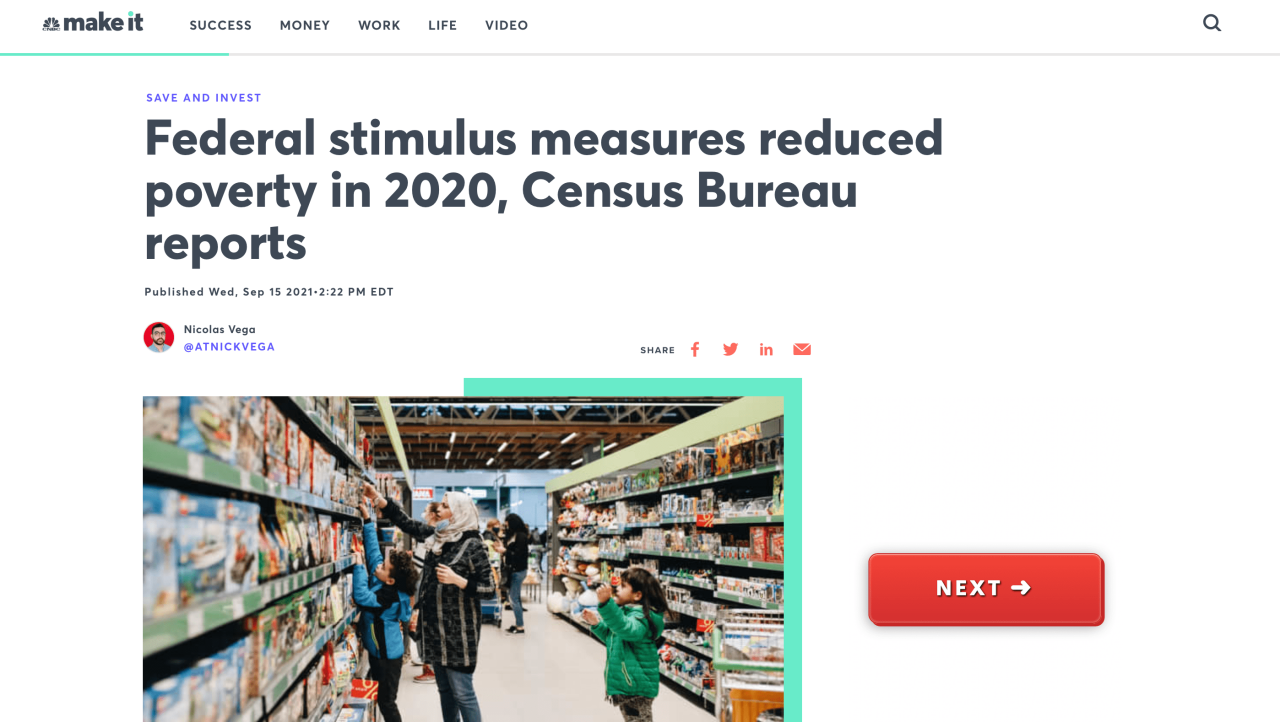Stimulus Check Program and its Effect on Poverty Rates is a topic that has sparked significant debate and analysis. The implementation of various stimulus check programs during economic downturns has raised crucial questions about their effectiveness in mitigating poverty and fostering economic recovery.
This paper explores the historical context, economic impact, and social implications of these programs, examining their influence on poverty rates and the broader socioeconomic landscape.
The paper delves into the intricacies of the stimulus check program, analyzing its design, eligibility criteria, and distribution methods. It investigates the correlation between stimulus payments and changes in poverty rates, drawing upon statistical data and research findings to assess the program’s effectiveness in reducing poverty across different demographic groups.
The paper also explores the broader economic and social consequences of the program, examining its impact on consumer spending, business activity, employment, income inequality, access to essential services, and overall well-being.
Stimulus Check Program Overview: Stimulus Check Program And Its Effect On Poverty Rates
The Stimulus Check Program, formally known as the Economic Impact Payments, was a series of government-issued payments distributed to eligible Americans during the COVID-19 pandemic. The program aimed to provide financial relief to individuals and families facing economic hardship due to widespread job losses and business closures.
The program was implemented in three phases, each with distinct eligibility criteria, payment amounts, and distribution methods.
History and Purpose of the Stimulus Check Program

The first round of stimulus checks was authorized by the CARES Act, signed into law in March 2020. This initial payment was designed to provide immediate economic support to individuals and families struggling with the early impacts of the pandemic.
Subsequent stimulus checks were authorized by the Consolidated Appropriations Act of 2021 and the American Rescue Plan Act of 2021, aiming to provide ongoing financial assistance as the pandemic persisted.
Details of the Stimulus Check Programs
- CARES Act (March 2020):This program provided up to $1,200 per individual and $2,400 per married couple, with an additional $500 per dependent child. Eligibility was based on income levels, with the maximum payment received by individuals earning up to $75,000 and married couples earning up to $150,000.
Remember to click How to Determine Your Stimulus Check Eligibility Online to understand more comprehensive aspects of the How to Determine Your Stimulus Check Eligibility Online topic.
- Consolidated Appropriations Act (December 2020):This program provided up to $600 per individual and $1,200 per married couple. The eligibility criteria were similar to the CARES Act, with the maximum payment received by individuals earning up to $75,000 and married couples earning up to $150,000.
- American Rescue Plan Act (March 2021):This program provided up to $1,400 per individual and $2,800 per married couple. The eligibility criteria were expanded to include individuals with higher income levels, with the maximum payment received by individuals earning up to $80,000 and married couples earning up to $160,000.
Economic Context
The implementation of the stimulus check programs occurred during a period of unprecedented economic disruption caused by the COVID-19 pandemic. The pandemic led to widespread job losses, business closures, and a sharp decline in economic activity. The stimulus checks were intended to mitigate the economic fallout by providing immediate financial relief to individuals and families, stimulating consumer spending, and supporting businesses.
Impact on Poverty Rates
The stimulus check programs were widely debated for their potential to reduce poverty rates in the United States. While the programs were not explicitly designed as poverty alleviation strategies, their direct cash transfers to low-income households were expected to have a positive impact on their financial security.
Correlation between Stimulus Checks and Poverty Rates
Research studies have shown a correlation between the receipt of stimulus check payments and reductions in poverty rates. For example, a study by the Center on Budget and Policy Priorities found that the CARES Act stimulus checks reduced the poverty rate by 1.7 percentage points in 2020.
Similarly, a study by the National Bureau of Economic Research found that the stimulus checks had a significant impact on reducing poverty among families with children.
Effectiveness of Stimulus Checks in Reducing Poverty
The effectiveness of stimulus checks in reducing poverty can be attributed to their direct impact on household income. By providing cash transfers to low-income families, the stimulus checks helped to offset lost wages, reduce food insecurity, and improve access to essential goods and services.
This, in turn, contributed to a decrease in poverty rates.
Expand your understanding about California Stimulus Check Distribution: Current Status with the sources we offer.
Impact on Different Demographic Groups
The impact of stimulus checks on poverty rates varied across different demographic groups. Studies have shown that the programs were particularly effective in reducing poverty among low-income households, families with children, and minorities. This is because these groups were disproportionately affected by the economic fallout of the pandemic and benefited most from the direct cash transfers.
Economic and Social Effects
The stimulus check programs had broader economic and social effects beyond their impact on poverty rates. These effects included changes in consumer spending, business activity, and employment, as well as implications for income inequality, access to essential services, and overall well-being.
Economic Consequences
The stimulus check programs had a significant impact on consumer spending. By providing cash transfers to households, the programs increased disposable income, leading to an increase in spending on goods and services. This boost in consumer demand helped to support businesses and stimulate economic activity.
Explore the different advantages of Stimulus Check Eligibility for Those with No Income that can change the way you view this issue.
Social Implications
The stimulus check programs also had social implications. The programs helped to reduce income inequality by providing financial assistance to low-income households. They also improved access to essential services, such as healthcare, food, and housing, by increasing the financial resources available to vulnerable populations.
Long-Term Effects
The long-term effects of the stimulus check programs on the economy and society are still being debated. Some argue that the programs helped to prevent a deeper economic recession and mitigated the negative social consequences of the pandemic. Others argue that the programs may have contributed to inflation and may have created a disincentive to work.
Find out about how Will You Get a Stimulus Check if You Owe Taxes? can deliver the best answers for your issues.
Policy Considerations and Alternatives
The stimulus check program has been praised for its effectiveness in providing immediate economic relief during a crisis. However, it has also been criticized for its cost and potential for long-term economic consequences.
Pros and Cons of Stimulus Checks
- Pros:
- Provides immediate financial relief to individuals and families.
- Stimulates consumer spending and economic activity.
- Reduces poverty rates and income inequality.
- Cons:
- High cost to taxpayers.
- Potential for long-term economic consequences, such as inflation.
- May create a disincentive to work.
Alternative Approaches to Addressing Poverty
- Expanding Social Safety Nets:Increasing the availability and accessibility of programs such as food stamps, Medicaid, and housing assistance.
- Investing in Education and Job Training:Providing opportunities for individuals to acquire skills and knowledge that will lead to better-paying jobs.
- Promoting Affordable Housing:Increasing the supply of affordable housing units to reduce homelessness and housing insecurity.
Effectiveness and Cost-Efficiency of Policy Options, Stimulus Check Program and its Effect on Poverty Rates
The effectiveness and cost-efficiency of different policy options for addressing poverty vary depending on the specific program and its implementation. It is important to consider the potential benefits and drawbacks of each option, as well as their impact on different demographic groups.
Future Directions
The future of stimulus check programs in the United States is uncertain. The programs were implemented as temporary measures to address the economic fallout of the COVID-19 pandemic. However, the possibility of future economic shocks or crises may necessitate the use of similar programs.
Potential Future of Stimulus Check Programs
The potential for future stimulus check programs will depend on a number of factors, including the severity of future economic crises, the availability of government resources, and public opinion.
Factors Influencing Future Policy Decisions
Future policy decisions related to economic relief measures will be influenced by factors such as the state of the economy, the political climate, and the availability of alternative policy options.
Evolving Stimulus Programs
Future stimulus programs may evolve to address emerging economic challenges and social inequalities. For example, future programs may focus on providing targeted assistance to specific groups, such as low-income workers or individuals affected by automation.
Wrap-Up
The analysis reveals that stimulus check programs have played a complex role in addressing poverty and economic hardship. While they have provided short-term relief and boosted consumer spending, their long-term effects on poverty reduction and income inequality remain a subject of ongoing debate.
The paper concludes by considering alternative policy approaches to poverty alleviation, emphasizing the need for a comprehensive and sustainable strategy that addresses the root causes of poverty and promotes economic opportunity for all.
Get the entire information you require about Where to Find Official Information on Stimulus Check Eligibility on this page.
Answers to Common Questions
What are the main arguments for and against stimulus check programs?
Proponents argue that stimulus checks provide immediate financial relief to low-income households, stimulate consumer spending, and boost economic activity. Critics argue that stimulus checks are inefficient, can lead to inflation, and may disincentivize work. They also contend that alternative approaches, such as job training and education programs, may be more effective in addressing poverty in the long term.
How do stimulus checks impact different demographic groups?
Research suggests that stimulus checks have had a disproportionate impact on low-income households, families with children, and minorities, as these groups tend to have higher poverty rates and rely more heavily on government assistance. However, the impact can vary depending on the specific design and implementation of the program.
What are the potential long-term effects of stimulus check programs?
The long-term effects of stimulus check programs are still being debated. Some argue that they can lead to a cycle of dependency on government assistance, while others believe they can provide a temporary lifeline that allows individuals and families to stabilize their finances and build a path to self-sufficiency.






